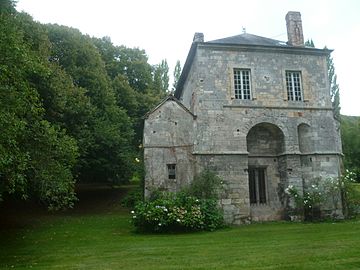Grestain Abbey facts for kids
Quick facts for kids Abbaye Notre-Dame de Grestain |
|
|---|---|
 |
|
| Religion | |
| Affiliation | Roman Catholic |
| District | Eure |
| Province | Upper Normandy |
| Ecclesiastical or organizational status | demolished |
| Year consecrated | 1050 |
| Location | |
| Location | Fatouville-Grestain |
| Architecture | |
| Architectural style | Norman |
| Website | |
| www.abbaye-de-grestain.fr | |
Grestain Abbey, also called Grestein Abbey, was an old Benedictine monastery in France. It was built in the 11th century near the town of Fatouville-Grestain. This area is now part of Upper Normandy. The abbey was part of the Catholic Church in the Diocese of Lisieux.
Grestain Abbey was very close to the family of William the Conqueror, who was the Duke of Normandy. After William conquered England, the abbey played a big role. It helped set up new churches and religious places in England. Many leaders from Grestain Abbey helped train English priests. Some churches mentioned in the famous Domesday Book of 1086 were started by Grestain Abbey.
A Look Back in Time
The Abbey was started in 1050 by a man named Herluin de Conteville and his wife, Herleva. Herleva was the mother of William the Conqueror, a very famous historical figure!
Herluin was suffering from a serious illness called leprosy. The story says he had a vision of the Blessed Virgin Mary. She told him to go to a special healing spring at Carbec, which means "the Stream of Kari."
After taking a treatment there, Herluin was cured! Because of this, he decided to build an abbey in the nearby Valley of Vilaine. He dedicated this abbey to the Virgin Mary. He also built a small chapel at Carbec, where the healing spring of Saint-Méen was located.
Herluin's son, Robert, Count of Mortain, was a half-brother of William the Conqueror. Robert was the main supporter of the abbey. He gave it money from his lands in England.
In 1358, the abbey was attacked and robbed by soldiers from England and Navarre. The monks had to escape to a safe house in Rouen. The abbey was attacked again between 1364 and 1365. When the monks returned, much of the abbey was destroyed.
The abbey was officially closed in 1757 by order of the bishop. The church buildings were torn down around 1766. The rest of the abbey was destroyed in 1790. Today, only a few ruins remain. These ruins are now part of a private home called the Château de La Pommeraye. You can still see parts of a defensive wall, a gate from the 13th century, and some remains of the old church.
A special monument has been built to remember the people who founded the abbey and were buried there. These include Herleva, Herluin, and Robert de Mortain. Robert's wife, Mathilde de Montgomerie, is also remembered there.
Abbey's Coat of Arms
The official symbol of the Abbey was a blue shield with three gold fleurs de lys on it. A fleur de lys is a stylized lily flower, often used in French symbols.
Abbey's Other Locations
Grestain Abbey also had several smaller religious houses called priories. These were like smaller versions of the main abbey.
- Saint-Astier, Dordogne: This priory was started by Geoffroi, who was the second leader (Abbot) of Grestain Abbey.
- Sainte-Scolasse or Saint-Nicolas-en-Scolasse (Sainte-Scolasse-sur-Sarthe): This one was founded by Herluin de Conteville, who started the main abbey.
- Saint-Nicol or Saint-Nicolas-du-Val-de-Claire: This priory was located near Honfleur. It was founded by William the Conqueror himself!
Important Burials
Many important people were buried at Grestain Abbey:
- Herluin de Conteville and his wife Herleva
- Robert, Count of Mortain and his wife Matilda (daughter of Roger de Montgomery, 1st Earl of Shrewsbury)

